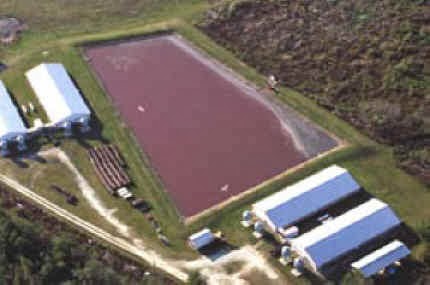 |
| This idyllic farm is actually a sanctuary where animals go when rescued from horrific factory farms and other abusive situations. |
To supply America's growing need for meat, dairy, and eggs, idyllic farms have been smothered with massive-scale factory farms. Aside from countless moral concerns, this method of farming is one of the biggest, and growing, threats to today's ecosystems.
 |
| A factory farm. The cows will spend the pretty much all of their lives in those cages—until they're lead the slaughter. |
Why is it such a problem?
 |
| An amazonian rainforest cut down for soybeans in cow food. |
 |
| A feces pit on a pig factory farm. It gets in pinkish color from not only poop, but blood. And anything else that falls through the pigs' cages and onto the collection tray. |
2. What goes in one end of an animal has to come out one way or another! When the manure falls through the bottom of an animal's cage, it is often dumped into a giant pit. Sometimes, the pit will leak and create giant swaths of devastated land.
3. The tools used to breed, keep, transport, slaughter, and process the animals are mechanical and consume monumental amounts of energy. First, energy is used to transport water to corn and soybean fields. Energy is used to harvest the crops, then transport them to the factory. Energy is used to manage the feeding and lighting, egg collection, artificial insemination. It's used when the animals are transported to the slaughter house. Chickens are often hung upside down on a conveyer belt while their heads are run through electrified water. Bigger animals, like cows and pigs, are killed by a bullet in their brain, or a knife to their throat, or being placed in boiling water. Then automated or semi-automated machines process the dead animals: skinning, feather-plucking, disemboweling, cutting, and packaging. Then the processed meat can be shipped to a warehouse or a store. All of this requires conveyer belts, wheels that turn around and deliver animals to different stations, funnels, pans, heating/searing units, tumbling—monumental amounts of energy.
What can you do to help?
A surprisingly easy thing to do is just eat less meat. Or no meat. You might say, "But I can't live without meat!" That's what I said just five years ago. Then I learned the truth about the meat factories of today and decided to make the leap. I ate a cheeseburger my very first day I said I was a vegetarian. But then the veggie habit just seemed to stick. Over the years, I've added layers to my vegetarianism: now I'm vegan, and don't eat or purchase anything derived from an animal. It certainly didn't happen overnight, but every little step counts toward a more forested, diverse, happy planet.
 |
| ...and let this jaguar roam the amazonian jungle! |
To learn more about...
- Becoming vegan: getvegucated.com
- Slaughterhouses: meat.org
- Health benefits: veganhealth.org
Some other helpful vegan/vegetarian links:
- compassionatecook.com
- 'Going Vegan' Slide Show
- peta.org - living food


No comments:
Post a Comment